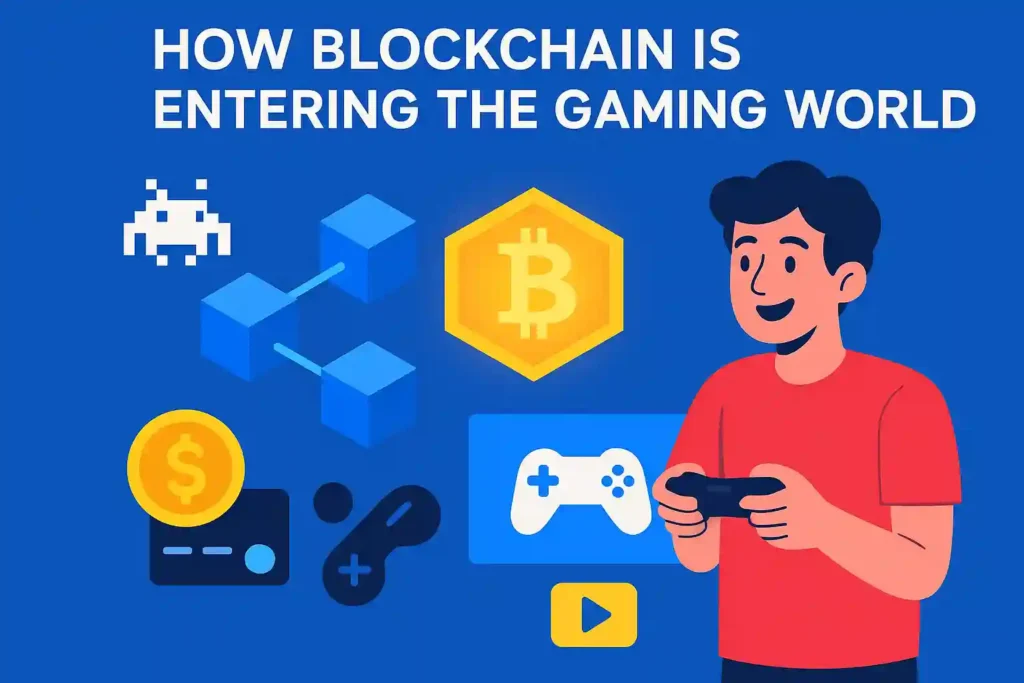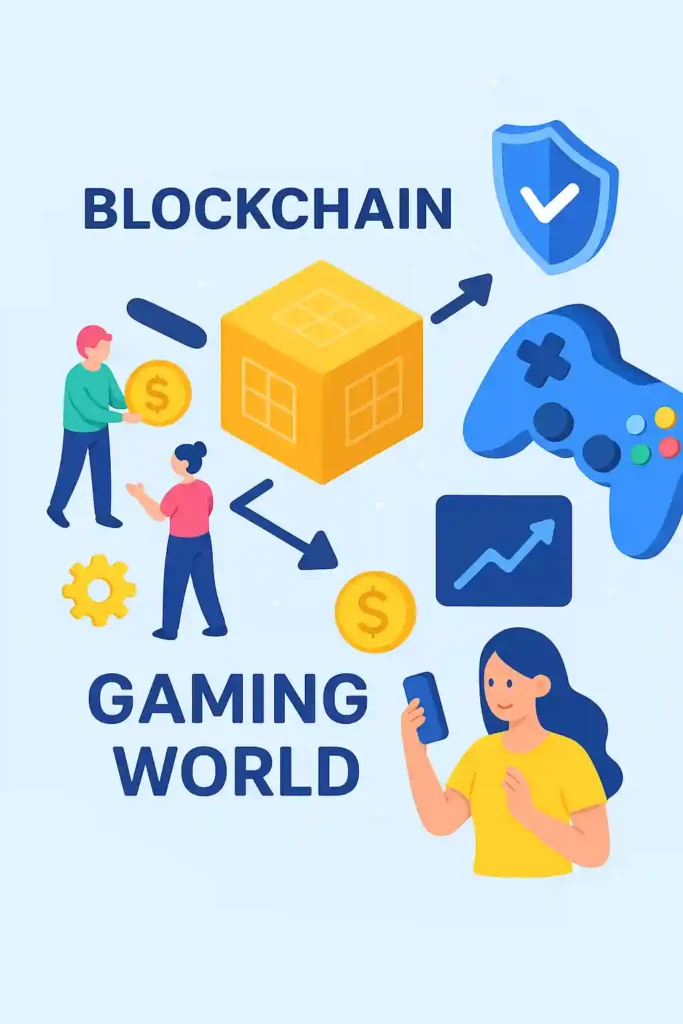Introduction
In recent years, the word blockchain(Chain Blocks) has been everywhere—often linked with cryptocurrencies like Bitcoin and Ethereum. But blockchain isn’t just about digital money. It’s also reshaping industries, and one of the most exciting areas it’s transforming is gaming.

From NFT-based items to play-to-earn models and decentralized marketplaces, blockchain technology is changing how games are played, how players are rewarded, and how virtual economies work. But what does this mean for gamers, developers, and the future of online entertainment?
Let’s dive into how blockchain is entering the gaming world, why it’s gaining attention, and what challenges it still faces.
A Quick Refresher: What Is Blockchain?
At its core, blockchain is a decentralized digital ledger that securely records transactions across a network. In gaming, this allows developers to create verifiable digital assets that players truly own — items, characters, skins, or even land within virtual worlds.
Key concepts include:
Non-Fungible Tokens (NFTs): Unique digital items like weapons, characters, or skins that can be bought, sold, or traded.
Play-to-Earn (P2E): A model where players earn real-world value through in-game activities.
GameFi: The intersection of gaming and decentralized finance, where tokens, staking, and yield farming are embedded in gameplay.
DAOs (Decentralized Autonomous Organizations): Player-led governance models giving communities a voice in how games evolve.
In gaming, this means transactions, items, and ownership records can be permanently tracked and verified without relying on one company to manage everything.
How Blockchain Is Entering Gaming
1. True Ownership of Digital Assets
2. Play-to-Earn (P2E) Models
3. Interoperability Between Games
4. Decentralized Marketplaces
5. Transparency and Security

1. True Ownership of Digital Assets
Traditionally, when you buy in-game items—like a skin, sword, or mount—you don’t really “own” it. The item exists on the developer’s servers, and if they shut down the game, it disappears.
Blockchain changes that by letting items exist as NFTs (non-fungible tokens). This gives players real ownership of their in-game assets, meaning they can:
Trade them with others.
Sell them on marketplaces.
Even use them across multiple games (if developers allow).
Example: Games like Axie Infinity and Gods Unchained let players own their digital cards or characters in ways that resemble real-world collectibles.
2. Play-to-Earn (P2E) Models
One of the biggest blockchain gaming trends is play-to-earn. Instead of playing just for fun, players can earn real-world value through gameplay.
Completing quests, battling monsters, or trading items can reward players with cryptocurrency or valuable NFTs.
In some regions, play-to-earn games have become sources of income.
Example: Axie Infinity allowed players in countries like the Philippines to earn enough from the game to support their families.
3. Interoperability Between Games
Blockchain opens the door to cross-game economies. Imagine earning a rare sword in one game and then being able to use, sell, or trade it in another.
This idea of interoperability—items existing independently of any single game—creates a metaverse-like experience where virtual worlds connect through shared assets.
4. Decentralized Marketplaces
Blockchain allows for peer-to-peer trading without middlemen. In traditional games, marketplaces are often controlled by developers, who take a cut from every trade.
In blockchain games:
Players can sell directly to each other.
Smart contracts ensure safe and transparent trades.
Prices are set by the market, not by the developer.
5. Transparency and Security
Cheating, fraud, and hacking are long-standing issues in online games. Blockchain helps reduce these risks because:
Every transaction is recorded on the blockchain.
Ownership can be verified instantly.
Rare items can’t be duplicated or faked.
For competitive games, this brings more fairness and trust to the system.
Benefits of Blockchain in Gaming
Empowers Players – Gamers finally get real ownership of their digital items.
New Revenue Streams – Both developers and players can earn from marketplaces and NFTs.
Global Economies – Items can hold real-world value across countries.
Decentralization – Less control by corporations, more freedom for communities.
Long-Term Value – Even if a game shuts down, NFTs can still exist and be traded.
Challenges Facing Blockchain Gaming
While blockchain gaming sounds revolutionary, it’s not without problems:
High Transaction Fees
Some blockchains (like Ethereum) charge high fees for transactions, making small trades impractical.Environmental Concerns
Certain blockchain systems use a lot of energy, raising concerns about sustainability.Scams and Speculation
The hype around NFTs has led to scams, pump-and-dump schemes, and overpriced items.Accessibility
Not all gamers understand crypto wallets, private keys, or blockchain mechanics, which creates a learning curve.Regulatory Uncertainty
Governments are still figuring out how to regulate blockchain-based assets, which could impact future growth.
Real-World Examples of Blockchain in Gaming
Axie Infinity – Popularized play-to-earn and NFT-based monsters.
The Sandbox – A virtual world where players buy land, build, and trade assets.
Decentraland – A metaverse-like space with virtual real estate and digital businesses.
Illuvium – A blockchain RPG with collectible creatures and battles.
Sorare – Fantasy sports meets blockchain, letting players trade licensed digital cards.
Key Trends in Blockchain Gaming (2025)
1. Cross-Chain Assets
Games are moving beyond single blockchains, allowing items and tokens to exist across Ethereum, Polygon, Solana, and more.
2. Eco-Friendly Solutions
Layer-2 scaling solutions and Proof-of-Stake consensus mechanisms reduce transaction costs and energy consumption.
3. Rise of DAOs
Player-led organizations are shaping development decisions, funding, and event management within virtual worlds.
4. Integration with AI
AI is being combined with blockchain to create smarter, dynamic in-game economies and adaptive gameplay.
5. Mainstream Adoption
AAA studios are beginning to test blockchain integration, signaling a future where Web3 mechanics are part of everyday gaming.
The Future of Blockchain in Gaming
Looking ahead, blockchain is likely to:
Integrate with Mainstream Games
We’ll see big studios experimenting with blockchain for skins, items, and events. Ubisoft has already tested NFTs in some of its titles.Boost the Metaverse
Shared assets across games could fuel interconnected worlds where players travel between virtual experiences seamlessly.Hybrid Models
Not all games will be fully blockchain-based. Many may mix traditional gaming with blockchain features like secure item ownership.More Regulation and Stability
As blockchain matures, governments will introduce clearer rules, which may make blockchain gaming safer and more reliable.
Should Players Be Excited or Cautious?
The truth is, blockchain gaming is still in its early days. It’s full of exciting possibilities, but also challenges. For some players, the chance to earn money while playing and truly own their items is groundbreaking. For others, the focus on crypto and NFTs feels distracting or even exploitative.
As with any new technology, balance is key. Games should remain fun first, with blockchain as an enhancer—not a replacement for good gameplay.
FAQs
Q1. Do I really own items in blockchain games?
Yes. Assets are recorded on the blockchain as NFTs, meaning they are yours to trade or sell outside the game.
Q2. Are blockchain games safe?
While transactions are secured by blockchain, risks like scams or hacks exist. Always use verified platforms and wallets.
Q3. Do I need cryptocurrency to play?
Some blockchain games require wallets and tokens, while others allow free entry with optional crypto integration.
Q4. Are blockchain games environmentally harmful?
Older Proof-of-Work blockchains were energy-intensive, but many gaming projects now use Proof-of-Stake, which is much greener.
Final Thoughts
Blockchain is entering the gaming world in a big way, bringing true ownership, play-to-earn models, decentralized marketplaces, and cross-game economies. While challenges like high fees, scams, and regulations remain, the potential is enormous.
If done right, blockchain could create a player-driven economy where digital assets hold real value and games become part of a larger interconnected universe.
One thing is clear: blockchain isn’t just a buzzword in gaming anymore—it’s a revolution that’s only just beginning.
